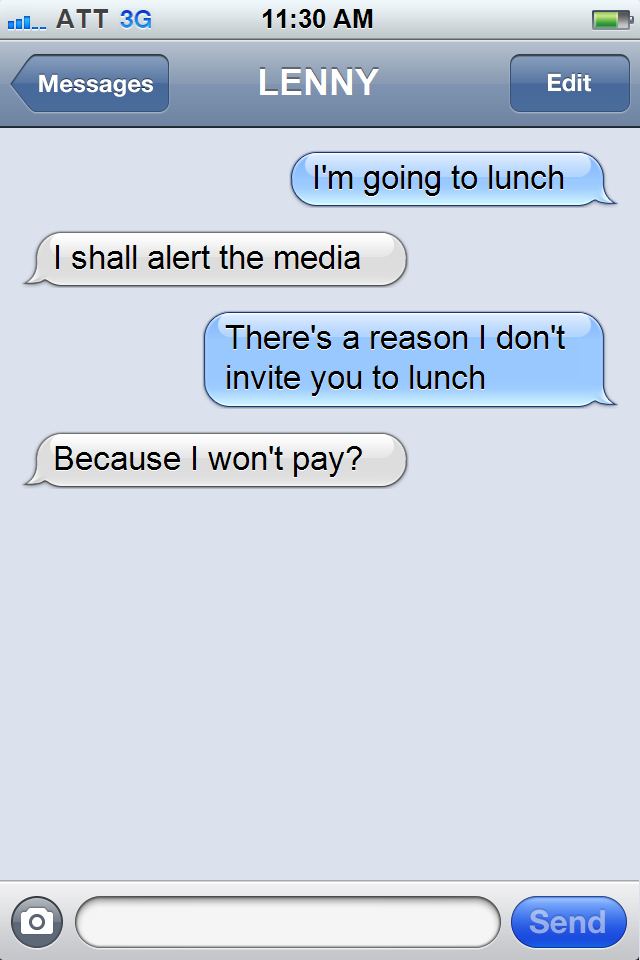Sarcastic Texts: The Art Of Witty Communication
Sarcastic texts have become a prevalent form of communication in the digital age, often blurring the lines between humor and insult. In a world where brevity is key, mastering the art of sarcasm through text messages can add an engaging twist to conversations. Sarcasm, when used effectively, not only lightens the mood but also showcases one's ability to think critically and creatively. In this article, we will explore the nuances of sarcastic texts, their impact on relationships, and tips for crafting the perfect sarcastic message.
From witty comebacks to playful banter, the use of sarcasm can enhance interactions among friends, colleagues, and even family members. However, it's essential to understand the context and audience when utilizing this form of humor. Misinterpretation can lead to misunderstandings, making it crucial to strike the right balance. This article will delve into various aspects of sarcastic texts, providing insights and examples to help readers navigate this complex communication style.
Whether you're looking to spice up your conversations or simply want to understand the psychology behind sarcastic communication, this comprehensive guide on sarcastic texts will equip you with the knowledge and skills necessary to master this art. Let's dive in!
Table of Contents
- What is Sarcasm?
- The Psychology of Sarcasm
- Benefits of Using Sarcasm
- How to Use Sarcasm in Texts
- Common Sarcastic Text Examples
- Sarcasm in Different Relationships
- Avoiding Misunderstandings with Sarcasm
- Conclusion
What is Sarcasm?
Sarcasm is a form of verbal irony where someone says the opposite of what they really mean, often for humorous or emphatic effect. It relies heavily on tone, context, and the relationship between the speaker and the listener. In written communication, such as texts, the lack of vocal tone and body language can make sarcasm more challenging to convey.
The Role of Context
The effectiveness of sarcasm is highly dependent on the context in which it is delivered. For example, a sarcastic remark made among friends may be received with laughter, while the same comment could be interpreted as offensive in a professional setting. Understanding the dynamics of your relationship with the recipient can help you gauge when it's appropriate to use sarcasm.
The Psychology of Sarcasm
The use of sarcasm often reflects a complex interplay of social intelligence and emotional awareness. Research suggests that individuals who can appreciate sarcasm tend to possess higher cognitive abilities and are more adept at recognizing social cues.
Empathy and Sarcasm
Interestingly, sarcasm can also serve as a tool for building empathy. By using humor to express frustration or disappointment, individuals can communicate their feelings without resorting to direct confrontation. This nuanced approach can foster understanding and strengthen relationships.
Benefits of Using Sarcasm
When used appropriately, sarcasm can offer several benefits, including:
- Enhancing Humor: Sarcasm adds a layer of humor that can lighten conversations.
- Building Rapport: Shared sarcastic exchanges can create a sense of camaraderie among friends.
- Encouraging Critical Thinking: Sarcasm often requires listeners to think critically about the underlying message.
- Reducing Tension: A well-timed sarcastic remark can diffuse a tense situation.
How to Use Sarcasm in Texts
Mastering the art of sarcastic texts involves several key strategies:
- Know Your Audience: Understanding the preferences and sensitivities of your audience is crucial.
- Use Emojis: Incorporating emojis can help convey tone and intent.
- Be Concise: Keep your messages short and to the point for maximum impact.
- Practice Timing: Choose the right moment to deliver your sarcastic remark for better reception.
Common Sarcastic Text Examples
Here are some examples of sarcastic texts that can add humor to your conversations:
- "Oh, great! Another Monday. Just what I needed!"
- "Thanks for the brilliant advice, Captain Obvious!"
- "I love waiting in line. It’s my favorite pastime!"
- "Sure, because I have all the time in the world!"
Sarcasm in Different Relationships
Sarcasm can be interpreted differently depending on the nature of the relationship:
Friends
Among friends, sarcasm often serves as a bonding mechanism, allowing for playful teasing and lighthearted exchanges.
Family
In family dynamics, sarcasm can sometimes be misinterpreted, so it's essential to approach it with care, especially with younger family members.
Workplace
In professional settings, sarcasm should be used sparingly to avoid misunderstandings or appearing unprofessional.
Avoiding Misunderstandings with Sarcasm
To minimize the risk of miscommunication when using sarcasm, consider the following tips:
- Be Clear: Ensure your sarcasm is evident through context or additional cues.
- Avoid Sensitive Topics: Steer clear of sarcasm related to personal or controversial issues.
- Check Reactions: Pay attention to how your audience responds to gauge if your sarcasm is well-received.
Conclusion
In conclusion, sarcastic texts can be a delightful addition to our communication repertoire when used thoughtfully and appropriately. By understanding the nuances of sarcasm and its implications in various relationships, you can enhance your interactions and foster deeper connections with others. Remember to keep your audience in mind, and don't hesitate to share your own experiences with sarcastic texts in the comments below!
If you enjoyed this article, feel free to share it with your friends or check out our other posts for more engaging content.
Understanding Goicoechea Age: A Comprehensive Guide
What's OAP: Understanding The Concept And Its Importance
Tiney Texie: The Rising Star Of Social Media


